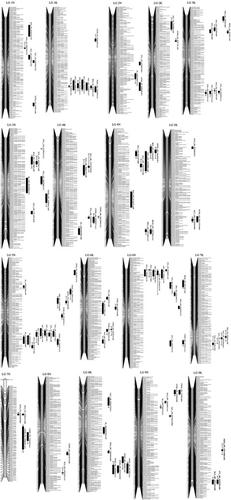当前位置:
X-MOL 学术
›
GCB Bioenergy
›
论文详情
Our official English website, www.x-mol.net, welcomes your
feedback! (Note: you will need to create a separate account there.)
Genome‐wide quantitative trait loci detection for biofuel traits in switchgrass (Panicum virgatum L.)
Global Change Biology Bioenergy ( IF 5.9 ) Pub Date : 2020-07-30 , DOI: 10.1111/gcbb.12731 Shahjahan Ali 1 , Desalegn D. Serba 2 , Dennis Walker 1 , Jerry Jenkins 3 , Jeremy Schmutz 3, 4 , Suresh Bhamidimarri 1, 5 , Malay C. Saha 1
Global Change Biology Bioenergy ( IF 5.9 ) Pub Date : 2020-07-30 , DOI: 10.1111/gcbb.12731 Shahjahan Ali 1 , Desalegn D. Serba 2 , Dennis Walker 1 , Jerry Jenkins 3 , Jeremy Schmutz 3, 4 , Suresh Bhamidimarri 1, 5 , Malay C. Saha 1
Affiliation

|
Switchgrass (Panicum virgatum L.) has been identified as a potential feedstock for cellulosic ethanol production in United States for its high biomass yield and adaptation to marginal lands. Composition of the cell wall plays an important role in bioethanol conversion. A total of 209 pseudo‐F1 testcross progenies obtained from a biparental cross, AP13 × VS16, were grown at three locations from 2008 to 2011. Near‐infrared spectroscopy was used to estimate cell wall composition from biomass harvested at maturity. A linkage map of the pseudo‐F1 testcross was constructed with 8,757 SNPs developed by genotyping‐by‐sequencing. Quantitative trait loci (QTL) analysis was performed on eight lignocellulosic traits, namely, klason lignin, sugar, glucose, xylose, hexose, ethanol, hexosoic ethanol, and cell wall ethanol conversion percentage. A total of 327 QTL were recorded for the eight lignocellulosic traits. We have identified 111 major regions in the switchgrass genome that underlie these lignocellulosic traits. Scanning of the genome sequence for genes flanking the QTL peaks, we identified 45 important genes that are involved in lignin biosynthesis, carbohydrate and sugar metabolism, and other biological and cellular functions. Identification of valuable genes associated with QTL along with pleotropic effects of the significant number of QTL suggests that simultaneous selection and genetic improvement of these traits are possible using marker‐assisted selection.
中文翻译:

全基因组定量性状基因座检测柳枝bio(Panicum virgatum L.)生物燃料性状
柳枝((Panicum virgatum L.)因其高生物量产量和对边缘土地的适应性而在美国被确定为纤维素乙醇生产的潜在原料。细胞壁的组成在生物乙醇转化中起重要作用。从2008年到2011年,从双亲杂交获得的209个伪F 1杂交试验后代AP13×VS16在三个位置生长。近红外光谱用于估计成熟时收获的生物量的细胞壁组成。伪F 1的链接图用基因分型测序方法开发的8,757个SNP构建了testcross。定量性状位点(QTL)分析进行了八个木质纤维素性状,即克拉森木质素,糖,葡萄糖,木糖,己糖,乙醇,己糖乙醇和细胞壁乙醇转化率。总共记录了八个木质纤维素性状的327个QTL。我们已经确定了柳枝genome基因组中这些木质纤维素特性的111个主要区域。扫描基因组序列中位于QTL峰两侧的基因,我们确定了45个重要的基因,它们参与了木质素的生物合成,碳水化合物和糖的代谢以及其他生物和细胞功能。
更新日期:2020-07-30
中文翻译:

全基因组定量性状基因座检测柳枝bio(Panicum virgatum L.)生物燃料性状
柳枝((Panicum virgatum L.)因其高生物量产量和对边缘土地的适应性而在美国被确定为纤维素乙醇生产的潜在原料。细胞壁的组成在生物乙醇转化中起重要作用。从2008年到2011年,从双亲杂交获得的209个伪F 1杂交试验后代AP13×VS16在三个位置生长。近红外光谱用于估计成熟时收获的生物量的细胞壁组成。伪F 1的链接图用基因分型测序方法开发的8,757个SNP构建了testcross。定量性状位点(QTL)分析进行了八个木质纤维素性状,即克拉森木质素,糖,葡萄糖,木糖,己糖,乙醇,己糖乙醇和细胞壁乙醇转化率。总共记录了八个木质纤维素性状的327个QTL。我们已经确定了柳枝genome基因组中这些木质纤维素特性的111个主要区域。扫描基因组序列中位于QTL峰两侧的基因,我们确定了45个重要的基因,它们参与了木质素的生物合成,碳水化合物和糖的代谢以及其他生物和细胞功能。











































 京公网安备 11010802027423号
京公网安备 11010802027423号